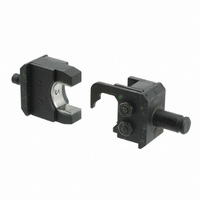47823 Tyco Electronics, 47823 Datasheet - Page 6

47823
Manufacturer Part Number
47823
Description
DIE TERMINYL 69051 2AWG
Manufacturer
Tyco Electronics
Datasheet
1.47820.pdf
(8 pages)
Specifications of 47823
Lead Free Status / RoHS Status
Not applicable / Not applicable
Each crimping die is thoroughly inspected before
packaging. Since there is a possibility of damage
during shipment, the crimping die should be inspected
immediately upon arrival at your facility.
Regular inspections should be performed by quality
control personnel. A record of scheduled inspections
should remain with the dies and/or be supplied to
supervisory personnel responsible for the dies.
Though recommendations call for at least one
inspection a month, the inspection frequency should
be based on the amount of use, ambient working
conditions, operator training and skill, and established
company standards.
It is recommended that each operator of the dies be
made aware of—and responsible for—the following
steps of daily maintenance:
of 8
1. Remove dust, dirt, and other contaminants with
a clean brush, or a soft, lint–free cloth. Do NOT
use objects that could damage the dies.
2. Make certain the dies are protected with a THIN
coat of any good SAE 20 motor oil. Do not oil
excessively.
3. When the dies are not in use, mate them and
store in a clean, dry area.
1. Remove all lubrication and accumulated film by
immersing the dies in a suitable commercial
degreaser that will not affect paint or plastic
material.
2. Make sure all die components are in place. If
replacements are necessary, refer to the
replacement parts listed in Figure 11.
3. Check components for wear. Remove and
replace worn components.
4. Inspect the crimp area for flattened, chipped,
cracked, worn, or broken areas. If damage is
evident, the dies must be repaired before returning
them to service (see Section 7, REPLACEMENT
AND REPAIR).
To avoid personal injury, ALWAYS release
hydraulic pressure to hose or control and
disconnect power unit from power supply before
performing maintenance or inspection procedure.
Tyco Electronics Corporation
The die closure inspection is accomplished using plug
gages. A suggested gage design and the GO and
NO–GO diameters of the plug gage elements are
shown in Figure 9. The following procedure is
recommended for inspecting the die closures.
If the crimping chamber conforms to the gage
inspection, the crimping die is considered
dimensionally correct and should be lubricated with a
THIN coat of SAE 20 motor oil. If not, the dies must
be repaired before returning them to service (see
Section 7, REPLACEMENT AND REPAIR).
Die Closure Configuration
1. Mate the dies until it is evident that they have
bottomed. Hold the dies in this position.
2. Align the GO element with the crimping
chamber. Push element straight into the crimping
chamber without using force. The GO element
must pass completely through the crimping
chamber as shown in Figure 10.
3. Align the NO–GO element and try to insert it
straight into the crimping chamber. The NO–GO
element may start entry but must not pass
completely through as shown in Figure 10.
47820
47821
47822
47823
47824
47825
47915
47918
GO Diameter
Suggested Plug Gage Design
10.185-10.193
12.675-12.682
14.249-14.257
11.354-11.361
[.2010-.2013]
[.2370-.2373]
[.2690-.2693]
[.3190-.3193]
[.4010-.4013]
[.4470-.4473]
[.4990-.4993]
[.5610-.5613]
6.020-6.027
6.833-6.840
5.105-5.113
8.103-8.110
Figure 9
NO-GO Diameter
25.4 [1.00]
(Min Typ)
10.335-10.338
12.824-12.827
14.399-14.402
11.504-11.506
[.2069-.2070]
[.2429-.2430]
[.2749-.2750]
[.3249-.3250]
[.4069-.4070]
[.4529-.4530]
[.5049-.5050]
[.5669-.5670]
5.255-5.258
6.170-6.172
6.982-6.985
8.252-8.255
Rev







